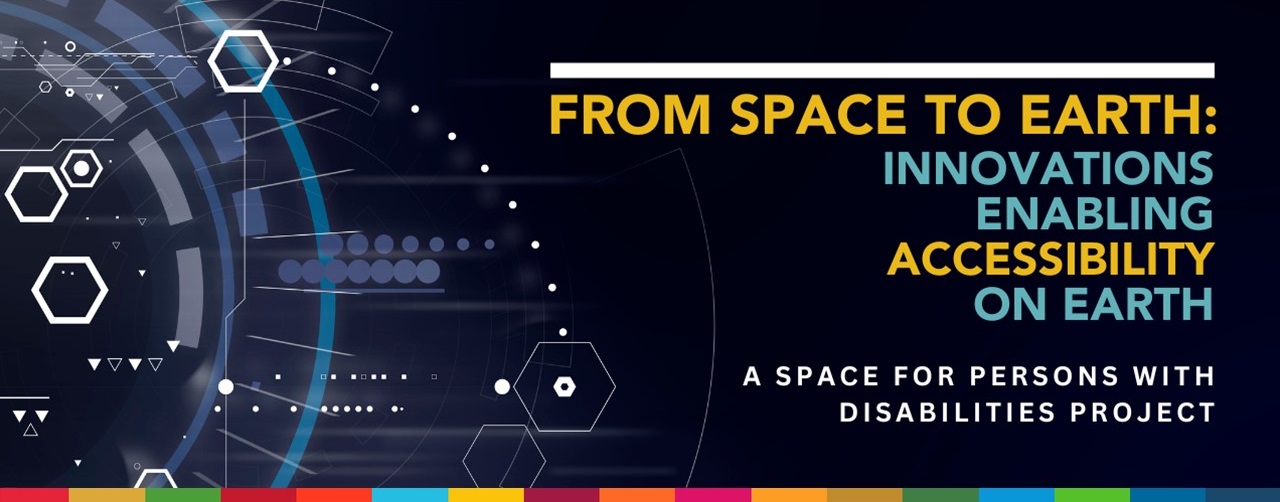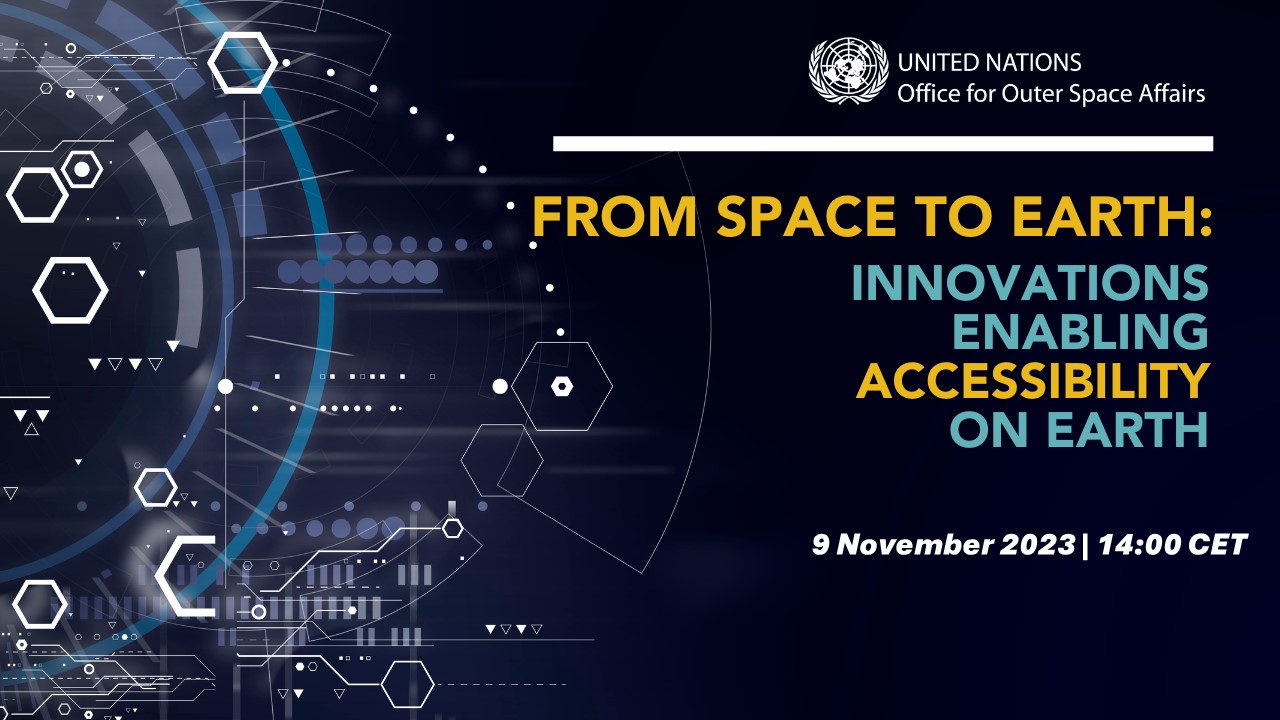Introduction
Over the past seven decades, space exploration has yielded remarkable technological advancements across engineering, computing, and life sciences. Through international collaboration between government agencies, academia and industries, many of these scientific developments have systematically found their way into consumer and household goods, as well as innovative solutions to benefit life on Earth.
The early space programmes for instance, played a crucial role in human performance research. By the mid-1960s, the first non-invasive behavioural and physiological sensors were being developed to monitor the well-being of space crew. Today, these have revolutionized health diagnostics, medical wearables, and telemedicine services. In addition, communication and control interfaces originally developed for astronauts, have progressively been adapted into assistive technologies for persons with limited mobility. With these alternative and augmentative communication means, individuals with physical impairment could better interact with their environment using gaze-, gesture-, and voice-controlled interfaces.
Interplanetary exploration has also pushed the boundaries of material engineering, navigation, guidance and control systems. A number of advanced materials used in spacecraft structures were determined in studies to be compatible with the human body and have been incorporated into the design of prosthetics and medical implants. Navigation systems on Earth further make use of remote sensing technology and geolocation data from space satellites, to benefit both individuals with and without visual impairments.
Fast forward to the 21 st century, advancements in computing and neuroscience have further optimized human-computer interfaces. These have led to improved cognitive support for space crew and people on Earth alike. In addition, the promise of 3D-bio fabrication and in-space manufacturing is expected to provide personalized and low-cost options in regenerative medicine, with pilot studies underway to produce synthetic muscles, knee cartilage and nerve tissues of the eye, among others.
In short, there has been a longstanding, synergistic effort to ensure that space spin-offs and technology transfer can empower persons with disabilities. From enhancing mobility and self-care tasks, to expanding engagement in education, employment, community, social, and civic life, the potential of space technologies is limitless.
Objectives
This project is a component of the UNOOSA Space for Persons with Disabilities initiative. This project aims to showcase examples where space technologies were repurposed to tackle everyday challenges faced by persons with disabilities to highlight the value of space for enabling accessibility. The project will provide an overview of the value of space technologies, in addition to featuring innovative, exploratory and emerging space-based solutions that have the potential to enhance accessibility for persons with disabilities.
Through this project, we hope to:
- Raise awareness of the benefits of space-based technologies and innovations in addressing barriers to accessibility for persons with disabilities.
- Showcase examples of space-based technologies and innovations that have successful real-world applications, as well as emerging technologies that have the potential to fundamentally change our world in the future.
- Foster international and interdisciplinary collaborations on technological solutions to advance accessibility and empower persons with disabilities.
- Identify key challenges and ideas to develop and implement space-based technologies for accessibility.
- Promote research, development, availability and use of space-based technologies, including information and communications technologies, mobility aids, devices and assistive technologies, suitable for persons with disabilities.
- Contribute to the implementation of SDG 10: Reduced Inequalities.
The value of space technologies
Satellite navigation
Global Navigation Satellite System (GNSS) is a network of satellites broadcasting timing and orbital information used for navigation and positioning measurements. GNSS provides precise positioning and guidance. It is commonly applied in five areas:
- Location - determining your position in the world
- Navigation - identifying the best route from one location to another
- Tracking - monitoring an object's movement in the world
- Mapping - creating maps of a specific area
- Timing - computing precise timing within billionths of a second
An example of how GNSS provides real-time navigation and inclusive mobility solution is street navigation applications that have been augmented with spatial audio or haptics to allow persons with vision impairment to navigate without relying on sight to look at a map.
Satellite communication
Satellite communications play a vital role in the global telecommunications system. Satellites orbiting Earth relay signals carrying voice, video, and data to and from one or many locations worldwide, thus providing communication links between various points on Earth.
Satellite communication is used in the field of telemedicine. On one end is the use of telephone and video conferencing services for consultations between patients and clinicians. On the other end of the spectrum are experimental innovations such as telesurgery which allow a surgeon to receive information to guide robotic instruments to perform surgery on a patient located in a distant site.
An example of how satellite communication is being used for accessibility is real-time interactive video conferencing between clinicians and patients, some patients may have limited mobility who have difficulty leaving their place of residence to visit a medical centre or are living in remote places with hard-to-reach healthcare.
Human spaceflight technologies
The outer space environment is harsh. Microgravity exposure and radiation pose significant threats to human health, including a number of physiological and biochemical changes in humans. Nevertheless, many of the technologies developed to enable humans to survive in space can also be applied to support humans on Earth. Furthermore, the challenges of limited resources, prolonged exposure to microgravity and psychological stresses as we send humans deeper into space for longer periods of time pose exciting opportunities in terms of breakthroughs in countermeasures, space medicine, material science, robotics and other fields.
The effects of microgravity environment on bone density is of particular interest because of its similarity to osteoporosis, a common medical condition among certain populations on Earth. Due to microgravity in outer space, bones have to support less weight and are subjected to less stresses in space as compared to on Earth. The drop in bone density, known as disuse osteoporosis, puts the astronaut at a higher risk of fracture upon return to Earth. Steps taken to slow down the loss of bone density, rehabilitation, testing and medication for astronauts may also help to prevent or alleviate osteoporosis on Earth.
Microgravity-induced bone and muscle loss can improve understanding of aging-related health problems and provide an environment for accelerated clinical studies.
Activities
[1] "From Space to Earth: Innovations enabling accessibility on Earth" webinar
When it comes to space technologies, the first thoughts that come to most people's minds are rockets, spaceships, and astronauts. But the benefits of going above and beyond can be found here on Earth through products and services originating from space innovations.
Following the UN/WHO Space for Global Health conference taking place from 1 to 3 November 2023 in Geneva, Switzerland, UNOOSA will be hosting a webinar to explore space-based technologies that improve accessibility, health care and quality of life for persons with disabilities. This event will bring together experts in the fields of physiology, robotics, accessibility and more, to showcase some of the most creative and impactful technologies, discuss the current state of space for global health market and future trends, and highlight opportunities for start-ups and SMEs to participate in this exciting field.
Join us as we bring you the benefits of space to humankind!
Date: 9 November 2023
Time: 14:00 to 15:30 CET
Location: Online, MS Teams
Programme:
- Opening statement: Luc St-Pierre, Chief of Space Applications Section, UNOOSA
- Market perspective on health and space: Thomas Crone, Business Analyst, ESA Commercialisation Gateway, European Space Agency
- Innovation showcases
-
- Astroskin - Vital signs monitoring platform : Pierre-Alexandre Fournier, CEO, Hexoskin, Canada
- HIFIm - Benefits for astronauts and earthlings : John Kennett, CEO, Physical Mind London, UK
- Regent suit - Development and implementation of space countermeasure technologies in terrestrial medicine: present and future : Elena S. Tomilovskaya, Head of the Department of Sensory-Motor Physiology and Countermeasures, Institute of Biomedical Problems of the Russian Academy of Sciences, Russia
- WaveOut - See the world through your ears : Hugo Furtado, CEO, Dreamwaves, Austria
- Opportunities in healthcare for startups and SMEs : Gerda Kuum, Market Development Expert, Market Downstream and Innovation Department, European Union Agency for the Space Programme
- Closing remarks
Registration: Closed
Resources:
- Presentation slides: Please click on the presentation titles in the Programme to download the presentation slides.
- Video recording: Click here to watch the video on UNOOSA YouTube channel.
[2] Featured innovations
Read about the innovations and their inspiring back stories in this series of articles. The articles are grouped according to the primary type of disability that the innovation addresses, even though some innovations may have multi-purposes. Both established and future technologies are featured, including basic technologies that have the potential to transform the way things are done fundamentally such as material science.
Click on the image to access the article.
I. Lift off: Enhancing mobility for all
II. Beyond 20/200: Using space-based technologies to support persons with visual impairments
III. The power of play: Using space-based technologies to support cognitive development
Article coming soon...
IV. Health monitoring and diagnostic applications
V. Cracking the code: Technologies of the future
Article coming soon...
Share an innovation
If you would like to share an innovation, please contact us at oosa@un.org. Our team will get back to you as soon as possible.
Contact
For more information, please email oosa@un.org.







